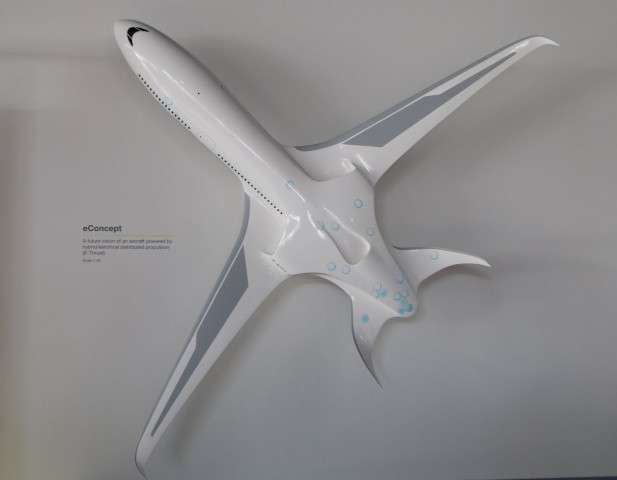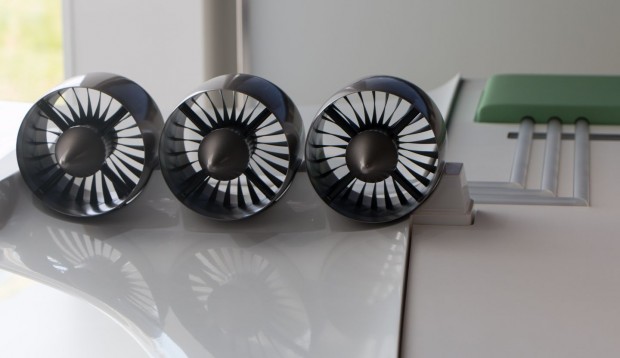Electric for regular airlines
Airbus is developing a passenger aircraft with a capacity of up to 80 people, which will be set in motion with the help of an electric drive. A small electric aircraft, acting as a test lab, has already been built.
At the moment, there are already aircraft for small aircraft with electric drive, such as the single Antares, or Elektra One Solar, or the double E-Fan from Airbus. However, EADS plans go further in the direction of creating an electric aircraft for regular flights.

')
The plane should have a capacity of up to 80 passengers and be used on flights of up to 3 hours, according to Jean Botti, technical director of the Airbus-Group. Thus, the aircraft will be well suited for regional lines.
Six engines: to create thrust, six electric motors with propellers encased by impellers (Mantelpropeller) will be used, as well as a conventional turbine. In this case, the turbine is used not to create thrust, but to generate electricity / charge batteries. Partially, 6 electric motors are responsible for charging, which can turn into electric power generators. As batteries, it is planned to use not lithium-polymer, but lithium-sulfur or lithium-air batteries.
drive model: in front - the usual turbine, rear - electric motors

The engines will not be located on hangers under the wings, as on many modern aircraft, but integrated into the structure of the aircraft. This allows you to make them more compact. Due to the reduction in size, it is necessary to increase their number, so six engines are needed to create the required thrust.

Superconducting cables : one of the key points in building an airplane is to save weight wherever you can. Conventional copper cables should be replaced by superconductors. The potential for saving weight is huge: a 30cm cable with copper cables rated for 4500 A, weighs 12 kg. A superconductor of the same length from Magnesium diboride (MgB2) weighs only 16 grams. However, superconductors operate only at very low temperatures and must be cooled to -247 degrees Celsius using a cryogenic plant.
The flight of such an aircraft may look like this: when you start and climb, you need a lot of energy, which is obtained from fully charged batteries. At the same time, a regular turbine for recharging batteries works at full speed. As soon as the aircraft reaches the required height and speed of about 880 km / h, the turbine mode of operation decreases.
Electric power in flight: when the plane is lowered, the turbine is first completely switched off. Then the plane goes into planning mode and at that moment the electric motors go into generator mode. The oncoming air flow spins the blades of electric motors, which generate electricity. Thus, when landing there is a necessary stock of electricity, the batteries are almost fully charged. For safety reasons, a conventional turbine is also launched before landing, so that in the event of an unforeseen situation, to have the possibility of rapid power generation.
Commissioning is not a matter of the near future. While Airbus presented in Munich a prototype electric drive. After two years, the system should be ready. The first prototype of the aircraft is expected in about 10 years.
With the help of the so-called E-Concept, Airbus wants to use the opportunity to enter the regional aircraft market, for which Airbus currently has no offers. The smallest A-series aircraft, the A318, holds about 100 passengers. However, sales of this type of aircraft are very low.
With capacity from 70 to 80 passengers, Airbus wants to compete on the European market for companies like Bombardier with the CRJ family of Embraer und Embraer planes with their E-Jet. Sales of these aircraft in the European market are quite successful, they are used by many airlines for regional flights and, especially, in small airports.
Together with Avroliner and some Fokker-70/100, they fill a niche in Europe between screw aircraft that require a very short runway and large-capacity aircraft, such as the Boeing 737 or Airbus 320 family.
Botti also notes that another significant advantage of electric airplanes is low noise. This will allow you to take off and landing, even at night.
Official video:
video.golem.de/wissenschaft/13074/elektroflieger-e-concept-airbus.html
Notes:
From the translator:
- At airports in Europe, there is often a ban on night flights.
- In addition to electroplanes, autonomous airframes with an electric motor and a propeller have been used for several years to gain height, which are folded inside the fuselage when climbing
At the moment, there are already aircraft for small aircraft with electric drive, such as the single Antares, or Elektra One Solar, or the double E-Fan from Airbus. However, EADS plans go further in the direction of creating an electric aircraft for regular flights.

')
The plane should have a capacity of up to 80 passengers and be used on flights of up to 3 hours, according to Jean Botti, technical director of the Airbus-Group. Thus, the aircraft will be well suited for regional lines.
Six engines: to create thrust, six electric motors with propellers encased by impellers (Mantelpropeller) will be used, as well as a conventional turbine. In this case, the turbine is used not to create thrust, but to generate electricity / charge batteries. Partially, 6 electric motors are responsible for charging, which can turn into electric power generators. As batteries, it is planned to use not lithium-polymer, but lithium-sulfur or lithium-air batteries.
drive model: in front - the usual turbine, rear - electric motors

The engines will not be located on hangers under the wings, as on many modern aircraft, but integrated into the structure of the aircraft. This allows you to make them more compact. Due to the reduction in size, it is necessary to increase their number, so six engines are needed to create the required thrust.

Superconducting cables : one of the key points in building an airplane is to save weight wherever you can. Conventional copper cables should be replaced by superconductors. The potential for saving weight is huge: a 30cm cable with copper cables rated for 4500 A, weighs 12 kg. A superconductor of the same length from Magnesium diboride (MgB2) weighs only 16 grams. However, superconductors operate only at very low temperatures and must be cooled to -247 degrees Celsius using a cryogenic plant.
The flight of such an aircraft may look like this: when you start and climb, you need a lot of energy, which is obtained from fully charged batteries. At the same time, a regular turbine for recharging batteries works at full speed. As soon as the aircraft reaches the required height and speed of about 880 km / h, the turbine mode of operation decreases.
Electric power in flight: when the plane is lowered, the turbine is first completely switched off. Then the plane goes into planning mode and at that moment the electric motors go into generator mode. The oncoming air flow spins the blades of electric motors, which generate electricity. Thus, when landing there is a necessary stock of electricity, the batteries are almost fully charged. For safety reasons, a conventional turbine is also launched before landing, so that in the event of an unforeseen situation, to have the possibility of rapid power generation.
Commissioning is not a matter of the near future. While Airbus presented in Munich a prototype electric drive. After two years, the system should be ready. The first prototype of the aircraft is expected in about 10 years.
With the help of the so-called E-Concept, Airbus wants to use the opportunity to enter the regional aircraft market, for which Airbus currently has no offers. The smallest A-series aircraft, the A318, holds about 100 passengers. However, sales of this type of aircraft are very low.
With capacity from 70 to 80 passengers, Airbus wants to compete on the European market for companies like Bombardier with the CRJ family of Embraer und Embraer planes with their E-Jet. Sales of these aircraft in the European market are quite successful, they are used by many airlines for regional flights and, especially, in small airports.
Together with Avroliner and some Fokker-70/100, they fill a niche in Europe between screw aircraft that require a very short runway and large-capacity aircraft, such as the Boeing 737 or Airbus 320 family.
Botti also notes that another significant advantage of electric airplanes is low noise. This will allow you to take off and landing, even at night.
Official video:
video.golem.de/wissenschaft/13074/elektroflieger-e-concept-airbus.html
Notes:
From the translator:
- At airports in Europe, there is often a ban on night flights.
- In addition to electroplanes, autonomous airframes with an electric motor and a propeller have been used for several years to gain height, which are folded inside the fuselage when climbing
Source: https://habr.com/ru/post/223883/
All Articles